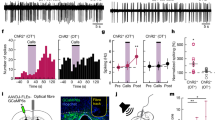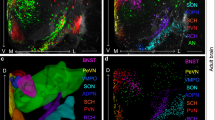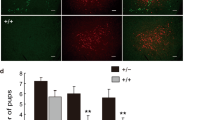Abstract
The hypothalamo-neurohypophysial system offers a unique example in the adult mammalian central nervous system (CNS) of a functional and structural plasticity related to a physiological state. During lactation, oxytocin neurones evolve a synchronized electrical activation which permits pulsatile hormone release at milk ejection1. At the same time, in the supraoptic (SON) and paraventricular nuclei, glial coverage of neurones diminishes, so that large portions of their surface membrane become directly juxtaposed; synaptic remodelling also associates pairs of neurones through the formation of common presynaptic terminals2–5. These structural changes, reversible after weaning4, affect exclusively oxytocinergic neurones5 and could facilitate their synchronized electrical activity. As several observations suggest that oxytocin itself is released centrally6–8, we have examined the effect of prolonged intracerebroventricular infusions of oxytocin on the structure of the SON of non-lactating animals. We report here that the peptide indeed engenders the structural reorganization characteristic of the oxytocin system when it is physiologically activated. Similar infusion of vasopressin has no effect. Our observations thus demonstrate that a central neuropeptide can induce anatomical changes in the adult CNS, and suggest that oxytocin can regulate its own release by contributing to the dramatic restructuring of the nuclei containing the neurones responsible for its secretion.
This is a preview of subscription content, access via your institution
Access options
Subscribe to this journal
Receive 51 print issues and online access
$199.00 per year
only $3.90 per issue
Buy this article
- Purchase on Springer Link
- Instant access to full article PDF
Prices may be subject to local taxes which are calculated during checkout
Similar content being viewed by others
References
Poulain, D. A. & Wakerley, J. B. Neuroscience 7, 773–808 (1982).
Theodosis, D. T., Poulain, D. A. & Vincent, J. D. Neuroscience 6, 919–929 (1981).
Hatton, G. I. & Tweedle, C. D. Brain Res. Bull. 8, 197–204 (1982).
Theodosis, D. T. & Poulain, D. A. Neuroscience 11, 183–193 (1984).
Theodosis, D. T., Chapman, D. B., Montagnese, C., Poulain, D. A. & Morris, J. F. Neuroscience 17, 661–678 (1986).
Moos, F. et al. J. Endocr. 102, 63–72 (1984).
Mason, W. T., Hatton, G. I., Ho, Y. W., Chapman, C. & Robinson, I. C. A. F. Neuroendocrinology 42, 311–322 (1986).
Theodosis, D. T. Nature 313, 682–684 (1985).
Cazalis, M., Dayanithi, G. & Nordman, J. J. J. Physiol., Lond. 369, 45–60 (1985).
Tweedle, C. D. & Hatton, G. I. Brain Res. 309, 373–376 (1984).
Chapman, D. B., Theodosis, D. T., Montagnese, C., Poulain, D. A. & Morris, J. F. Neurosdence 17, 679–686 (1986).
Robinson, I. C. A. F. Prog. Brain Res. 60, 129–145 (1983).
Sofroniew, M. V. in Handbook Chemical Neuroanatomy Vol. 4, Pt 1 (eds Bjorklund, A. & Hokfelt, T.) 93–165 (Elsevier, Amsterdam, 1985).
Freund-Mercier, M. J. & Richard, P. J. Physiol., Lond. 352, 447–466 (1984).
Author information
Authors and Affiliations
Rights and permissions
About this article
Cite this article
Theodosis, D., Montagnese, C., Rodriguez, F. et al. Oxytocin induces morphological plasticity in the adult hypothalamo-neurohypophysial system. Nature 322, 738–740 (1986). https://doi.org/10.1038/322738a0
Received:
Accepted:
Issue Date:
DOI: https://doi.org/10.1038/322738a0
This article is cited by
-
The transition to motherhood: linking hormones, brain and behaviour
Nature Reviews Neuroscience (2023)
-
Astroglial Regulation of Magnocellular Neuroendocrine Cell Activities in the Supraoptic Nucleus
Neurochemical Research (2021)
-
Activation of the Oxytocin Receptor Modulates the Expression of Synaptic Adhesion Molecules in a Cell-Specific Manner
Journal of Molecular Neuroscience (2019)
-
Developmental Perspectives on Oxytocin and Vasopressin
Neuropsychopharmacology (2015)
-
Dendritic peptide release and peptide-dependent behaviours
Nature Reviews Neuroscience (2006)
Comments
By submitting a comment you agree to abide by our Terms and Community Guidelines. If you find something abusive or that does not comply with our terms or guidelines please flag it as inappropriate.



